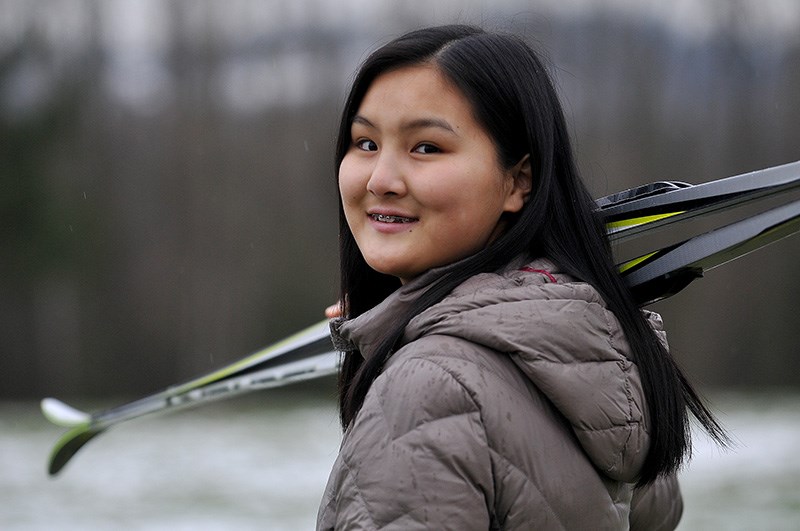You might have reached for your remote when biathlon came on the TV coverage of the 2018 Winter Olympics in Pyeongchang, South Korea. Jesserin Tang reached for her notepad.
For the 18-year-old Port Coquitlam woman, the Olympic biathlon competition presented a rare opportunity to watch and learn from the sport’s best athletes; it’s not like we have Biathlon Night in Canada on television every Saturday.
Tang has been part of a program to introduce and foster the sport to air cadets for three of the five years she’s been a member of the Royal Canadian Air Cadets 777 Neptune squadron in Port Coquitlam.
Recently, Tang and another member of the squadron, 13-year-old Athena Cai, joined more than 80 other athletes at a provincial competition at Mt. Washington in Comox in hopes of achieving a spot on the BC national cadet biathlon team that will travel to Charlottetown, PEI, for the national cadet championship March 5-10. They finished fifth.
Tang said she joined the biathlon program because she wanted to learn how to ski for free. Biathlon combines the disciplines of cross-country skiing with marksmanship as athletes have to pause several times around a kilometres-long course to fire a rifle at targets on a range. Competitors race against the clock or each other and each missed target means added time or skiing a 150m penalty loop.
Tang said the sport is a fun way to test her capabilities she’s developed as part of the squadron’s range team for five years, and her fitness and emerging skills as a skier. But it’s far from easy.
“I didn’t expect it to be so hard,” she said. “You get tired when you’re skiing and you have to control your breathing when you reach the range.”
Tang’s coach, Lawrence Goh, said top biathletes are able to focus and slow their heartbeat after the physical exertion of skiing.
“You need a lot of time to learn that skill.”
Goh, who’s been guiding the biathlon program at RCAC 777 squadron for five years, said the sport is a natural fit for one of the aims of cadets — to promote physical fitness in youth aged 12-18 as they develop skills that might interest them in the sea, land and air activities of the Canadian Armed Forces.
But practising a sport in the temperate Lower Mainland that requires a good ground covering of snow in proximity to a shooting range comes with its own challenges. Goh’s team skis at Cypress Mountain and hones their shooting skills at the Port Coquitlam & District Hunting and Fishing Club. The two aspects are only able to come together on ventures to the Whistler Olympic Park.
In the meantime, Goh has his team work on their strength and endurance by running laps around Percy Perry Stadium’s track.
“You need stamina,” he said.
Tang admits she’s a long way from reaching the level of biathletes competing at the Winter Olympics. But being able to watch them on TV has at least given her an idea of how much she has to learn.
“I actually understand it a bit more and have a whole new appreciation for the sport,” she said.
Goh hopes the exposure that comes from the Games will attract newcomers to biathlon. Or at least reduce the glazed looks he gets when he tries to recruit cadets to his program.
“We have to explain what biathlon is to them,” he said.
A biathlon primer
So you want to be a biathlete?
Here’s what you might want to know about the sport that traces its roots to military skiing contests in Norway in the 1700’s but didn’t have a recognized world championship until 1958. Two years later it was included in the Olympics for men, but women weren’t allowed to compete until the 1992 Games in Albertville, France.
• Individual international races are 20 km (15 km for women) that are skied over five laps. Competitors pause at the range between each of those laps to shoot four times at targets 50 metres away. The targets have a 45mm diameter when the competitors are shooting from the prone position (lying on their belly) and 115mm when shooting from a standing position. Competitors must hit all 20 targets in 20 shots and each miss is penalized by adding extra time to their finish.
• Sprint races are 10 km for men and 7.5 km for women, skied over three laps with two pauses at the range where competitors must hit all 10 targets with their total of 10 shots. Each missed target means they have to ski a 150-metre penalty lap.
• There are also pursuit, relay and mass start races with their own variations of distance and shooting rules.
• Biathletes can ski using classic cross-country or the free (skate-style) techniques.
• The small-bore .22 calibre bolt-action rifle athletes use on the range must weigh at least 3.5 kg. It must be carried by the skier on their back.
• Canada’s Myriam Bédard is the only North American biathlete to win an Olympic gold medal. She won gold in the 15 km individual women’s race, and 7.5 km women’s sprint at the 1994 games in Lillehammer, Norway. She also won a bronze in the 15 km individual event at the 1992 games in Albertville, France.



